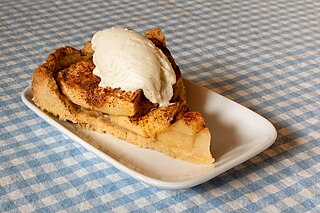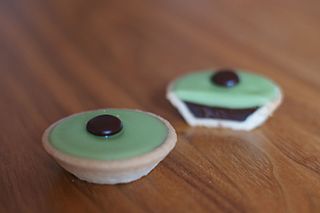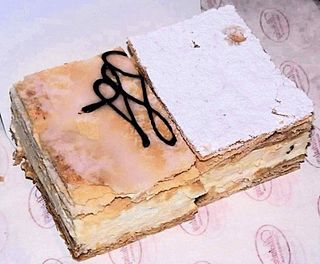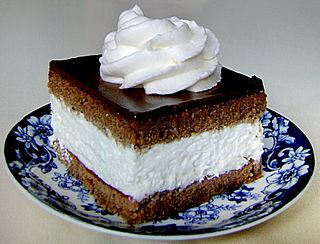
Dessert is a course that concludes a meal. The course consists of sweet foods, such as confections, and possibly a beverage such as dessert wine and liqueur. In some parts of the world, such as much of Central Africa and West Africa, and most parts of China, there is no tradition of a dessert course to conclude a meal.

Pastry is baked food made with a dough of flour, water and shortening that may be savoury or sweetened. Sweetened pastries are often described as bakers' confectionery. The word "pastries" suggests many kinds of baked products made from ingredients such as flour, sugar, milk, butter, shortening, baking powder, and eggs. Small tarts and other sweet baked products are called pastries. Common pastry dishes include pies, tarts, quiches, croissants, and pasties.

An apple pie is a pie in which the principal filling ingredient is apples. The earliest printed recipe is from England. Apple pie is often served with whipped cream, ice cream, or cheddar cheese. It is generally double-crusted, with pastry both above and below the filling; the upper crust may be solid or latticed. The bottom crust may be baked separately ("blind") to prevent it from getting soggy. Deep-dish apple pie often has a top crust only. Tarte Tatin is baked with the crust on top, but served with it on the bottom.

A profiterole, cream puff (US), or chou à la crème is a filled French choux pastry ball with a typically sweet and moist filling of whipped cream, custard, pastry cream, or ice cream. The puffs may be decorated or left plain or garnished with chocolate sauce, caramel, or a dusting of powdered sugar. Savory profiterole are also made, filled with pureed meats, cheese, and so on. These were formerly common garnishes for soups.

Funnel cake is a regional sweet food popular in North America, found mainly at carnivals and amusement parks.

A mille-feuille ,, also known by the names Napoleon, vanilla slice, and custard slice, is a dessert made of puff pastry layered with pastry cream. Its modern form was influenced by improvements made by Marie-Antoine Carême.

Apple cakes are cakes in which apples feature as a main flavour and ingredient. Such cakes incorporate apples in a variety of forms, including diced, pureed, or stewed, and can include common additions like raisins, nuts, and 'sweet' spices such as cinnamon or nutmeg. They are a common and popular dessert worldwide, thanks to millennia of apple cultivation in Asia and Europe, and their widespread introduction and propagation throughout the Americas during the Columbian Exchange and colonisation. As a result, apple desserts, including cakes, have a huge number of variations.

Kuchen, the German word for cake, is used in other languages as the name for several different types of savory or sweet desserts, pastries, and gateaux. Most Kuchen have eggs, flour and sugar as common ingredients while also, but not always, including some fat. In Germany it is a common tradition to invite friends over to one's house or to a cafe between noon and evening to drink coffee and eat Kuchen.

Choux pastry, or pâte à choux, is a delicate pastry dough used in many pastries. Basic ingredients usually only include butter, water, flour and eggs.

A Swiss roll, jelly roll, roll cake, cream roll, roulade or Swiss log is a type of rolled sponge cake filled with whipped cream, jam, or icing. The origins of the term are unclear; in spite of the name "Swiss roll", the cake is believed to have originated elsewhere in Central Europe, possibly Austria or Slovenia. It appears to have been invented in the nineteenth century, along with Battenberg cake, doughnuts, and Victoria sponge. In the U.S., commercial versions of the cake are sold with the brand names of Ho Hos, Yodels, Swiss Cake Rolls, and others. A type of roll cake called Yule log is traditionally served at Christmas.

The St. Honoré cake, usually known by its French name gâteau St-Honoré, and also sometimes called St. Honoratus cake, is a pastry dessert named for the French patron saint of bakers and pastry chefs, Saint Honoré or Honoratus, Bishop of Amiens. It was invented in 1847 at the Chiboust bakery on Rue Saint-Honoré in Paris.

A cremeschnitte, also known as vanilla slice or custard slice, is a custard and chantilly cream cream cake dessert commonly associated with the former Austro-Hungarian Monarchy. However, its exact origin is unknown. This dish remains popular across Central Europe and the Balkans in various variations, all of which include a puff pastry base and custard cream.

Nun's farts are a dessert pastry originally from France, where they were known as pets-de-nonne, and which are now also produced in French Canada, the United States, England, and Spain.

Carac is a tart-like Swiss dessert pastry traditionally made of ingredients such as chocolate, cream, fondant, and shortbread pie crust, usually found in the French part of Switzerland.

Napoleonka, colloquially kremówka, is a Polish type of cream pie. It is made of two layers of puff pastry, filled with whipped cream, creamy buttercream, vanilla pastry cream or sometimes egg white cream, and is usually sprinkled with powdered sugar. It also can be decorated with cream or covered with a layer of icing.

Wuzetka is a chocolate sponge and cream pie which originated in Warsaw, Poland. Its name is probably derived from the Warsaw W-Z Route, on which the confectionery that first began to sell the dessert in late 1940s was located. Traditional to Varsovian cuisine, the dessert was exclusively served by cafés and restaurants in Warsaw, but soon became a beloved home-made food in Poland.
















